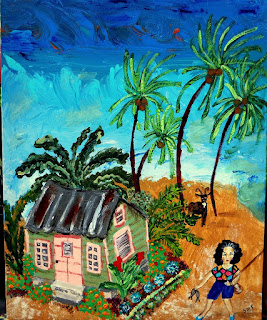The
Chattel Houses on the Caribbean island of Barbados are a common
sight, often taken for granted by those who reside there and see them
every day. Dating back to “plantation days,” these tiny two room
cottages were designed to be movable and transported when needed.
Approximately 12 x 20 feet, and made of wood (without using any
nails), they were positioned on concrete blocks, stones, or even a
small hill. Sometimes, a small shed could be attached to the back for
a bathroom of sorts.
The
name “Chattel” comes from the French term, for a movable
possession, and therefore, not real estate. Emancipated slaves were
allowed to own homes, but they could not own land. Therefore, they
created these small portable cabins. The owner of the house had to
take it wherever he found work, from one (sugar) plantation to
another, and would rent a small parcel of land for his house from his
employer. If there was a landlord/tenant dispute, the owner of the
house had to leave – and take his house with him. The walls of the
home could be taken apart easily and placed on a flat bed truck, or a
wagon pulled by a mule or horse. Once they reached their new
location, the house could be reassembled as before.

 |
| "Aunt Mae's Chattel House," by Stacey Torres |
Today,
the island is still dotted with these curious little homes. They have
a simple design of two windows and a center door to the front; and
windows on each side (I'm not certain of the back). The windows were
usually jalousie windows, or have storm shutters, and sometimes just
open with no glass. Many of the houses are on permanent locations now
with foundations, running water and electricity. Some have been
refurbished and fitted to accommodate tourists and/or for commercial
use. However, some of the original older houses are merely lived in
as always.
 |
| "Da Neighbor's Goat," by Stacey Torres |
 |
| "Saturday Morning," by Stacey Torres |
Homeowners
were working class people. They took tremendous pride in their homes,
painting them in gorgeous color combinations and using fretwork as
trim that served to give a tiny bit of shade and protect the wooden
structure from weather. There are newer large homes built in the
style of the original Chattel House, but nothing can ever take the
place of these early “tiny homes.” Small, practical and
transportable. The unique style of these sweet little houses are even
more pronounced when you see one or two additions added on. The
original starter house was once called a “One Roof.” If you added
a shed, it was called “One Roof and a Shed.” If you added an
addition, it would be a “Two Roof House and Shed.” The roofs were
typically made of corrugated iron.
 |
| "Today Was Catchin' Day" by Stacey Torres |
My
maternal family's roots are from this island. I visited there in 1967
when my grandparents went on a pilgrimage back home for their 50th
wedding anniversary. I was fortunate to visit the tiny Chattel House
where my grandfather, Arthur Clement Moore, was born and raised. His
two older sisters and some young cousins were still living there. I
saw their gardens, their goats, their shed. However, they had
graduated to electricity and plumbing by then. Like so many other
Chattel Houses, this one had an addition built onto the back. I often dream of that little house and the garden of peppers and squash, and
the goats that stood guard. It's funny how my memories always take me
back to the gardens of my youth. It
is my ultimate goal to be able to travel back to Barbados someday
soon, to spend some time there finding my people and painting the
beloved Chattel Houses of Bimsha (a nickname of endearment for the
island).
So,
I've been working on a series of beautiful little Chattel Houses, the
way I remember them. These
charming treasures, deep in the history of my people were built and
remain full of pride and love. I'm sharing my heritage with you as
part of my exhibit, "Stacey Torres: Living In Color," May
13 to June 17, at the Henry County Art Center. Commissioned paintings are possible.
 |
| "Share N Share Alike" by Stacey Torres |
Originally published in The Courier-Times, April 2017






